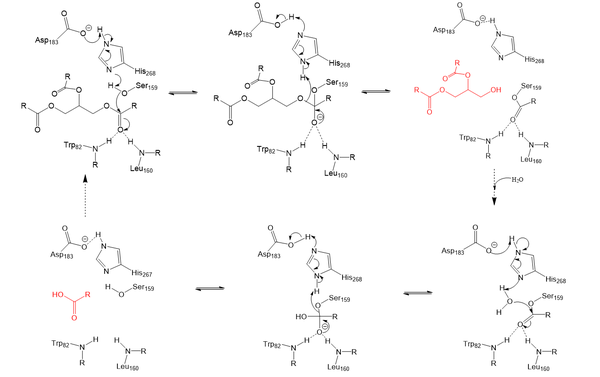User:Maggie Stopa/Sandbox 1
From Proteopedia
(Difference between revisions)
| Line 16: | Line 16: | ||
== Relevance & Disease == | == Relevance & Disease == | ||
| - | LPL is an extremely important enzyme, in that it is responsible for the proper breakdown of certain fats in the body. LPL breaks down triglycerides carried | + | LPL is an extremely important enzyme, in that it is responsible for the proper breakdown of certain fats in the body. LPL breaks down triglycerides carried in chylomicrons, otherwise known as very low-density lipoproteins ([https://en.wikipedia.org/wiki/Very_low-density_lipoprotein VLDL]). Chylomicrons carry digested fats in the form of triglycerides out of the small intestine and into the bloodstream. LPL recognizes the chylomicrons, and hydrolyzes the associated triglycerides. When triglycerides are not broken down properly and are allowed to build up, they can lead to increased plasma triglyceride levels ([https://en.wikipedia.org/wiki/Hypertriglyceridemia hypertriglyceridemia]) and [https://en.wikipedia.org/wiki/Cholesterol cholesterol] buildup. Hypertriglyceridemia is very unhealthy and is the leading cause of [https://my.clevelandclinic.org/health/diseases/16898-coronary-artery-disease Coronary Artery Disease] in America. Cholesterol buildup is caused by excess fats (triglycerides) and is a similarly serious issue with regards to obesity and heart disease in the United States as it can lead to plaque buildup in arteries and veins, which restricts blood flow. [https://medlineplus.gov/ency/article/000405.htm Chylomicronemia], which is defined as an excess of chylomicrons in the blood, is the disease characterized by the body being deficient in LPL resulting in persistent hypertriglyceridemia. This disease causes the body to be unable to digest very much ingested fats, and often leads to severe abdominal discomfort and several episodes of acute pancreatitis. In short, without LPL in the body, triglycerides are unable to get broken down, and there is a much higher likelihood of developing coronary & metabolic based diseases. |
== Structural highlights == | == Structural highlights == | ||
Revision as of 15:57, 26 April 2021
Lipoprotein Lipase LPL
| |||||||||||


